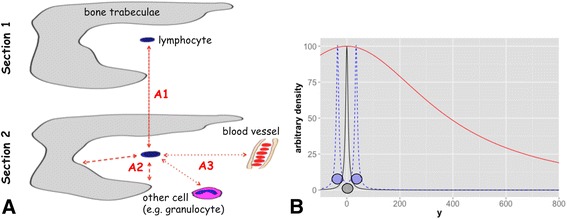Fig. 1.

Illustration of the task and the solution via a RBF. a: Sketch of two serial sections where a single lymphocyte in the centre could be appreciated in both sections. (A1) One task is to colocalize this cell/its immunohistochemical staining in both sections. (A2) Another task is to measure its distance to the bone trabeculae. (A3) Furthermore, is should be allocated to niches via measuring its distance to certain objects (bone trabeculae, other cells, vessels). b: By usage of different parameters (β and γ in equation 1) a RBF for direct and indirect spatial interaction could be modelled according to the particular image resolution/pixel-distance relation. The parameters are here chosen to accomplish a shape for RBFdirect, which represents potential direct object-object interaction, and for RBFindirect, which represents paracrine interaction. Black solid line: One point at position xp = 0 (representing a nucleus) is convoluted with an inverse, multiquadric basis function for direct interaction (RBFdirect with β = 3 and γ = 0.01). For illustration purposes the RBF is only shown with one variable. As a consequence, every point in this figure (xЄ [−100,800]) has an arbitrary scalar field value [arbitrary density]. Blue dashed line: Overlay of two fields for direct interaction, where one represents a centroid at xp = −50 and one at xp = 50.Red solid line: The single point at position xp = 0 is convoluted with an inverse, multiquadric basis function for indirect interaction (RBFindirect with β = 3 and γ = 0.00002)
